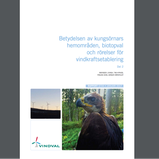Camera trap monitoring of nests
|
We have started to receive fascinating insights into Golden eagle biology from our Camera trap monitoring of nests. Here are some snapshots.
|
|
In News

Our new technical report is now out.
The report can be found here .
Singh, N.J., Hipkiss, T., Ecke, F, Hörnfeldt, B. (2017) Betydelsen av kungsörnars hemområden, biotopval och rörelser för vindkraftsetablering Del 2 / Movement patterns of golden eagles and importance for wind power development in Sweden Part 2.
The report can be found here .
Singh, N.J., Hipkiss, T., Ecke, F, Hörnfeldt, B. (2017) Betydelsen av kungsörnars hemområden, biotopval och rörelser för vindkraftsetablering Del 2 / Movement patterns of golden eagles and importance for wind power development in Sweden Part 2.
Master Thesis Presentation of Eirini-Lamprini Daouti.
Breeding dynamics of Golden Eagle (Aquila chrysaetos) population in the boreal forest of Sweden.
2017-01-20, 1300 in Laxen Hall at SLU, Umeå
Breeding dynamics of Golden Eagle (Aquila chrysaetos) population in the boreal forest of Sweden.
2017-01-20, 1300 in Laxen Hall at SLU, Umeå
New Publication on Breeding habitat selection. May 2016.
Habitat selection by adult Golden Eagles Aquila chrysaetos during the breeding season and implications for wind farm establishment.
Abstract
Capsule: Global Positioning System (GPS)-tagged adult Golden Eagles Aquila chrysaetos breeding in forests in northern Sweden selected clear-cuts, coniferous forests with lichens and steep slopes during the breeding season but avoided wetlands and mixed forest.
Aims: To investigate the habitat selection patterns of tree-nesting Golden Eagles, and identify how potential conflicts with wind farm development could be minimized.
Methods: The study is based on GPS tracking data from 22 adult eagles. We estimated home range sizes using a biased random bridge approach and habitat selection patterns using resource selection functions following a use-availability design.
Results: Core home range size among adults was variable during the breeding season (5–30 km2 ). Individual movement extents were variable, but sexes did not significantly differ in their scale of movement. At the landscape scale, individuals selected for clear-cuts and coniferous forest with ground lichens, whereas wetland, water bodies and mixed forest were avoided. Steeper and south facing slopes were selected for, whereas, north facing slopes were avoided.
Conclusions: Potential conflicts between eagles and wind energy establishment can be reduced if wind farms are placed away from steep slopes, minimizing areas that are clear-cut during construction, and locating turbines within dense, young and other less favoured forest habitats.
Habitat selection by adult Golden Eagles Aquila chrysaetos during the breeding season and implications for wind farm establishment.
Abstract
Capsule: Global Positioning System (GPS)-tagged adult Golden Eagles Aquila chrysaetos breeding in forests in northern Sweden selected clear-cuts, coniferous forests with lichens and steep slopes during the breeding season but avoided wetlands and mixed forest.
Aims: To investigate the habitat selection patterns of tree-nesting Golden Eagles, and identify how potential conflicts with wind farm development could be minimized.
Methods: The study is based on GPS tracking data from 22 adult eagles. We estimated home range sizes using a biased random bridge approach and habitat selection patterns using resource selection functions following a use-availability design.
Results: Core home range size among adults was variable during the breeding season (5–30 km2 ). Individual movement extents were variable, but sexes did not significantly differ in their scale of movement. At the landscape scale, individuals selected for clear-cuts and coniferous forest with ground lichens, whereas wetland, water bodies and mixed forest were avoided. Steeper and south facing slopes were selected for, whereas, north facing slopes were avoided.
Conclusions: Potential conflicts between eagles and wind energy establishment can be reduced if wind farms are placed away from steep slopes, minimizing areas that are clear-cut during construction, and locating turbines within dense, young and other less favoured forest habitats.
Dr. Tim Hipkiss represented the project at a recent Wind Energy conference. The poster can be accessed on the publications page.
See our new animations of the high resolution data on eagles around wind farms.
Spännande forskning på gång om kungsörnen. SOF Birdlife.
Spännande forskning på gång om kungsörnen. SOF Birdlife.
Vacancies
Master Thesis Projects at SLU.
1. Flight behaviour of Golden eagles in response to wind farms.
2. Relative role of life history and land use in determining movement strategies of Golden eagles.
For more information about the projects, please email [email protected], or call 0706760103.
1. Flight behaviour of Golden eagles in response to wind farms.
2. Relative role of life history and land use in determining movement strategies of Golden eagles.
For more information about the projects, please email [email protected], or call 0706760103.
